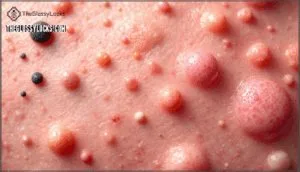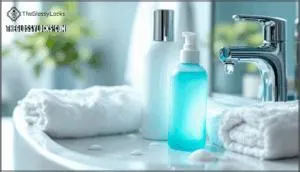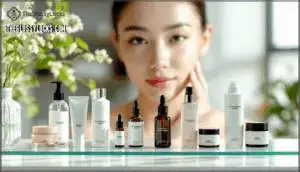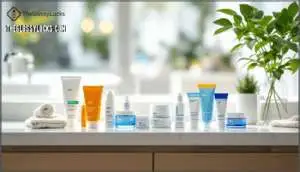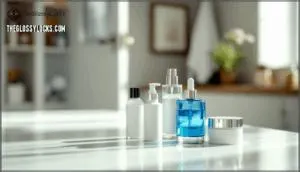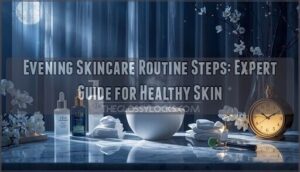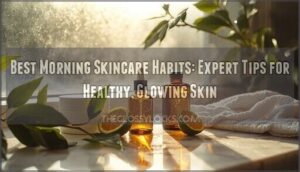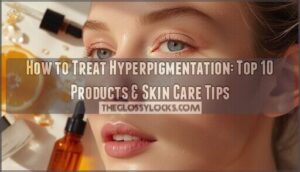This site is supported by our readers. We may earn a commission, at no cost to you, if you purchase through links.
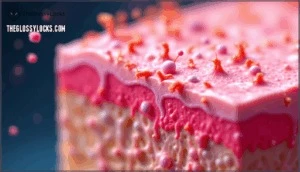
Effective acne treatment requires more than spot-checking visible blemishes. Your skin produces excess sebum, harbors bacteria, and reacts to hormonal fluctuations in ways that create the perfect environment for recurring breakouts.
Understanding these root causes allows you to build a prevention strategy that stops acne before it starts rather than reacting to each new flare-up.
Table Of Contents
- Key Takeaways
- What Causes Acne Breakouts?
- Types of Acne and Their Symptoms
- Effective Daily Skincare for Prevention
- Over-the-Counter Acne Treatments
- Prescription Options for Stubborn Acne
- Lifestyle Changes to Prevent Future Breakouts
- When to Consult a Dermatologist
- Frequently Asked Questions (FAQs)
- Conclusion
Key Takeaways
- Acne breakouts stem from four interconnected root causes—excess sebum production, bacterial overgrowth (Cutibacterium acnes), hormonal fluctuations (especially androgens), and inflammation—which means effective treatment requires addressing these underlying mechanisms rather than just treating visible pimples.
- Prevention-focused daily skincare using non-comedogenic products, gentle cleansing twice daily, and targeted ingredients like salicylic acid for pore-clearing or benzoyl peroxide for bacteria control can stop breakouts before they start when applied consistently over 6-8 weeks.
- Prescription options including oral antibiotics, hormonal therapy (birth control or spironolactone for women), topical retinoids, and isotretinoin for severe cases should be considered when over-the-counter treatments fail after three months or when scarring becomes a concern.
- Lifestyle modifications that genuinely impact acne include avoiding high-glycemic foods and dairy products, managing stress levels, maintaining 7-9 hours of quality sleep, and implementing immediate post-workout cleansing to prevent sweat-related breakouts.
What Causes Acne Breakouts?
Acne breakouts don’t happen by accident. Your skin reacts to specific triggers that set the stage for clogged pores and inflammation.
Understanding these underlying causes helps you target the root of the problem instead of just treating symptoms.
Hormonal Changes and Acne
When your hormones shift—whether you’re hitting puberty, dealing with your menstrual cycle, or experiencing pregnancy—your oil glands can kick into overdrive and trigger breakouts.
Androgen levels rise during puberty onset and fluctuate throughout your menstrual cycle, which explains why hormone imbalance often leads to acne flare-ups.
Conditions like PCOS acne are driven by elevated androgens, though hormone therapy or birth control pills can help regulate these hormone changes and reduce breakouts.
Excess Sebum Production
Your skin’s oil glands can pump out more sebum than necessary, creating a slick environment where dead skin cells stick together and clog your pores. When sebum androgens stimulate your sebaceous glands, you’ll notice increased oil production that contributes to breakouts.
Several factors drive excessive sebum:
- Androgens trigger sebaceous oil glands during hormonal shifts
- Larger pore size allows more oil accumulation
- Oily skin types naturally produce excess sebum
- Dehydrated skin can paradoxically boost oil production
- Overactive oil glands create ideal conditions for acne formation
Managing sebum levels through proper skin hydration helps prevent future breakouts.
Bacteria and Inflammation
Once oil clogs your pores, a bacteria called Cutibacterium acnes moves in and triggers an inflammatory response that turns a simple blockage into a red, swollen pimple. Your immune system detects this bacterial infection and sends white blood cells to fight it off. This defense mechanism creates the inflammation you see as acne breakouts.
Different bacterial strains affect your acne microbiome differently, and overusing antibiotics can lead to antibiotic resistance that makes acne treatment harder.
Genetic and Environmental Factors
Beyond bacterial infection and inflammation, your risk of developing acne breakouts depends heavily on genetic predisposition and environmental triggers. Twin studies show that genes account for 81% to 85% of acne causes. If you have a family history of acne, you’re more likely to experience early onset and severe cases.
Environmental factors like pollution, heat, and humidity also worsen acne treatment outcomes by increasing sebum production and triggering oxidative stress. Climate change can also affect acne by altering skin physiology.
Socioeconomics and epigenetic changes further influence who develops acne and how severely it affects them.
Types of Acne and Their Symptoms
Not all acne looks the same. Understanding the different types helps you recognize what you’re dealing with and how serious it might be.
Here’s what you need to know about the main categories of acne lesions.
Whiteheads, Blackheads, and Pimples
The bumps on your skin aren’t all created equal—knowing which type you’re dealing with can help you treat them the right way. Here’s what sets them apart:
- Whiteheads form when trapped oil and dead skin cells stay sealed under the surface
- Blackheads develop through oxidation when pores stay open and darken on exposure to air
- Pimples show inflammation with redness and tenderness around clogged follicles
- Extraction techniques work differently for each type and require gentle care
- Scarring potential increases when you pick or squeeze these blemishes
Proper acne treatment and prevention start with identifying what you’re facing.
Papules, Pustules, Nodules, and Cysts
When acne goes deeper than the surface, you’re dealing with inflammatory lesions that need more aggressive treatment. Papules appear as small red bumps without visible pus. Pustules develop when white blood cells collect, creating that telltale yellow center.
Nodules form deep under your skin as hard, painful lumps. Cysts go even deeper, causing the most severe scarring risks.
These inflammatory types demand prompt acne treatment to prevent permanent damage.
Acne Severity Levels
Understanding acne grading helps you recognize when you need stronger acne treatment. Dermatologists assess lesion counts and inflammatory lesions to classify severity. Here’s how clinicians categorize acne breakouts:
- Mild acne: Mostly blackheads and whiteheads with few inflammatory lesions
- Moderate acne: More papules and pustules appearing across affected areas
- Severe acne: Deep nodules and cysts with significant scarring risk
- Treatment response: Your severity level determines whether you need prescription options or severe acne treatments
- Acne prevention: Early intervention reduces acne scars and future complications
To accurately determine the best course of action, doctors use different acne grading systems.
Effective Daily Skincare for Prevention
Your daily skincare routine is your first line of defense against future breakouts. The right approach can keep your pores clear and your skin balanced without aggravating existing acne.
Here’s what you need to know about building an effective prevention-focused regimen.
Cleansing and Moisturizing Tips
Washing your face might seem basic, but doing it wrong can actually trigger more breakouts than it prevents. Use lukewarm water and a gentle cleanser twice daily to maintain your skincare routine without stripping natural oils. Always follow with a lightweight moisturizer suited to your skin type to keep your skin barrier healthy and balanced.
| Do This | Avoid This |
|---|---|
| Wash morning and night with gentle cleansing motions | Scrubbing harshly or washing more than twice daily |
| Choose fragrance-free skincare products | Using alcohol-based or heavily scented products |
| Pat dry and apply moisturizer immediately | Rubbing skin roughly or skipping moisturizer |
Choosing Non-Comedogenic Products
Not all skincare products are created equal, and some can actually sabotage your efforts by clogging pores before you even realize it. Look for noncomedogenic products on labels—these won’t block follicles or worsen breakouts.
Test new items one at a time in your skin care routine to identify what works for your skin type. Choose brands with solid reputations for acne prevention and ingredient awareness when building your daily skin care regimen.
Makeup Removal and Skin Hygiene
Leaving makeup on overnight is like rolling out the red carpet for bacteria—your pores become clogged and inflammation follows. Remove all makeup before bed using a double cleansing method—start with an oil-based cleanser to break down makeup, then follow with a gentle water-based product.
Clean your makeup brushes weekly to prevent bacteria buildup. This nighttime routine is essential for acne prevention and keeping your skin care routine effective.
Over-the-Counter Acne Treatments
You don’t always need a prescription to start fighting acne. Many effective treatments are available over the counter at your local pharmacy or drugstore.
Here’s what works and how to use these options to keep your skin clear.
Salicylic Acid and Benzoyl Peroxide
Two powerhouse ingredients dominate over-the-counter acne treatment: salicylic acid and benzoyl peroxide. Salicylic acid offers acid exfoliation that unclogs pores and prevents future breakouts through preventative use. Benzoyl peroxide benefits include killing acne-causing bacteria and reducing inflammation.
You can use these topical acne treatments separately or try treatment combination approaches for stubborn cases. Start with lower concentrations to minimize skin irritation. Apply benzoyl peroxide in the morning and salicylic acid at night for best results.
Topical Retinoids for Prevention
Retinoids work one step ahead by preventing clogs before they form and speeding up cell turnover to keep pores clear. Over-the-counter options like adapalene offer preventative benefits without a prescription.
Start with pea-sized amounts two to three times weekly to minimize potential side-effects like dryness and peeling. Long-term use delivers the best results for acne treatment and fading acne scars.
When to Use Spot Treatments
While retinoids address prevention over weeks and months, spot treatments jump in when you need targeted relief for pimples that have already surfaced.
Apply benzoyl peroxide or salicylic acid directly to active blemishes once or twice daily. These topical acne medications work best on fresh breakouts rather than as preventative spot use.
Don’t layer multiple spot treatments at high ingredient concentration levels—that invites irritation without faster results.
Prescription Options for Stubborn Acne
When over-the-counter treatments aren’t enough to control your breakouts, prescription medications can make a real difference. Your dermatologist has several powerful options to target stubborn acne that won’t respond to drugstore products.
Here’s what you need to know about the main prescription treatments available.
Oral Antibiotics and Retinoids
When topical treatments aren’t cutting it, your dermatologist might reach for oral antibiotics or retinoids to tackle acne from the inside out. Oral antibiotics fight bacteria and reduce inflammation, but you’ll usually take them for just a few months to avoid antibiotic resistance.
Retinoids work differently by unclogging pores and preventing new breakouts, though retinoid side-effects like dryness require monitoring progress closely.
Combination therapy often delivers the best results.
Hormonal Therapy for Acne
If your acne flares up around your period or resists standard treatments, hormonal therapy might be the missing piece. Birth control pills (COCs) reduce acne lesions by 55% on average, while spironolactone improves acne in 75-90% of women at doses of 50-100 mg daily.
These hormone therapy options address hormonal acne by blocking androgens or regulating hormone fluctuations. Topical anti-androgens like clascoterone offer another route with minimal systemic effects.
Safety profiles show manageable side effects, and using these treatments aids antibiotic stewardship by reducing reliance on oral antibiotics for acne treatment.
Isotretinoin for Severe Cases
For nodular or cystic acne that won’t quit, isotretinoin stands as the most powerful oral medication dermatologists can prescribe. This prescription acne medication clears severe acne and reduces acne scars but remains a last resort when alternative options fail.
Treatment duration runs four to six months with significant isotretinoin side-effects like dry skin and strict pregnancy risks requiring monthly monitoring. You’ll need regular blood work and contraception counseling before starting.
Lifestyle Changes to Prevent Future Breakouts
Your daily habits play a bigger role in acne prevention than you might think. Small adjustments to your routine can make a real difference in keeping your skin clear.
Let’s look at three key areas where lifestyle changes can help stop breakouts before they start.
Diet and Acne Myths
You’ve probably heard that greasy food and chocolate cause breakouts, but research tells a different story. Multiple studies show no direct link between eating fried foods and acne development.
Despite popular belief, greasy foods and chocolate don’t directly cause acne—research finds no clear link between fried foods and breakouts
The real culprit is often high glycemic index foods and dairy impact. Milk products increase acne risk, with skim milk showing the strongest association. Sugar correlation is also significant—high-sugar diets more than double your chances of current acne.
The gluten myth lacks evidence in non-celiac individuals. Chocolate link remains unclear, though milk chocolate shows higher acne risk than dark chocolate.
Managing Stress and Sleep
Stress doesn’t cause acne, but it can turn a few small breakouts into a full-blown flare. When stress hormones spike, your skin produces more oil and inflammation increases. Sleep quality matters too—poor rest disrupts skin repair and worsens acne triggers.
Here’s your acne management plan:
- Practice relaxation techniques like deep breathing or meditation for stress reduction
- Maintain consistent routines for sleep and selfcare
- Aim for 7-9 hours of quality sleep nightly
- Track your acne breakouts to identify stress-related patterns
Exercise and Skin Health
Regular exercise boosts blood flow to your skin and helps flush out toxins, but sweating during workouts can trigger breakouts if you don’t manage it right. Sweat mixes with bacteria and oil on your skin, causing inflammation and clogged pores.
Your post-workout skincare routine matters more than the exercise itself. Shower immediately after workouts using a gentle cleanser. Wipe down gym equipment before use for proper gym hygiene.
Stay hydrated to support skin health and maintain your skin’s natural moisture barrier during acne treatment.
When to Consult a Dermatologist
You can manage most acne with over-the-counter products and good skincare habits. Sometimes your skin needs more targeted help than you can provide at home. Knowing when to seek professional care can prevent long-term scarring and get your breakouts under control faster.
Signs You Need Professional Help
If your skin isn’t responding to over-the-counter treatments after three months, it’s telling you something important. Seek professional help when you notice:
- Persistent breakouts that won’t clear despite consistent treatment
- Severe inflammation with painful nodules or cysts beneath the skin
- Scarring concerns or dark marks that worsen over time
- Treatment resistance to multiple acne treatments you’ve tried
- Psychological impact affecting your confidence or daily life
A dermatologist can evaluate your skin condition and prescribe stronger medications to prevent lasting acne scars.
Treatment for Acne Scarring
Once active breakouts subside, you may face a different challenge: permanent marks left behind. Acne scars treatment requires professional intervention since home remedies rarely deliver results.
Your dermatologist has several proven acne treatment options depending on scar type. Laser treatments like Laser Resurfacing target deeper tissue layers to stimulate collagen production. Microneedling Therapy creates controlled micro-injuries that trigger healing responses. Chemical Peels remove damaged surface layers for smoother texture. Dermal Fillers raise depressed scars temporarily. Surgical Excision removes individual deep scars through minor procedures.
Starting treatment early prevents scars from becoming more difficult to correct.
Special Considerations During Pregnancy
Pregnancy hormones often trigger breakouts, but many standard acne treatments aren’t safe for you or your developing baby. Your dermatologist can recommend safe acne treatment options during pregnancy:
- Topical azelaic acid for mild to moderate hormonal acne
- Glycolic acid peels performed under medical supervision
- Benzoyl peroxide in low concentrations (2.5%)
- Avoid oral acne medication like isotretinoin and certain antibiotics
- Discuss breastfeeding safety before resuming retinoids postpartum
Postpartum acne may persist during breastfeeding, requiring continued medication risk assessment.
Frequently Asked Questions (FAQs)
Can acne products cause initial skin purging?
Yes, certain acne products can trigger skin purging when you first start using them. Retinoids and chemical exfoliants accelerate skin cell turnover, bringing underlying breakouts to the surface faster.
This purging timeline usually lasts two to six weeks and differs from true skin irritation or allergic reactions.
How long until treatments show visible results?
Most people wait forever—but realistically, topical acne medications show improvement in six to eight weeks, while prescription medications may take three to four months for full results.
Treatment Timelines depend on skin sensitivity, product absorption, and acne healing time, so maintain realistic expectations with maintenance therapy.
Should I continue treatment after acne clears?
Most dermatologists recommend staying on maintenance therapy even after your skin clears.
Preventative skincare using lower-strength topical treatments helps guarantee long-term benefits and relapse prevention.
Gradually tapering prescription medications with your provider keeps breakouts from returning.
Can I combine different acne treatments safely?
Combining acne treatments sounds like a great idea—until your face stages a rebellion. You can layer certain products safely, but mixing retinoids with benzoyl peroxide or stacking multiple active ingredients without professional guidance risks severe skin sensitivity and irritation.
Does sunscreen worsen acne or cause breakouts?
Sunscreen won’t cause breakouts if you choose non-comedogenic formulations designed for your skin type. Look for oil-free products with comedogenic ratings below two.
Apply these acne-friendly skin care products using gentle techniques that complement your acne treatment options.
Conclusion
Think of acne treatment like tending a garden—you can’t just pull weeds after they sprout. You need to prepare the soil and prevent seeds from taking root. Your commitment to acne treatment to prevent future breakouts means addressing sebum control, bacterial balance, and hormonal triggers before lesions form.
The products you choose today shape your skin’s environment tomorrow. Consistent prevention beats reactive spot treatment every time. Clear skin doesn’t happen by chance. It happens by design.

